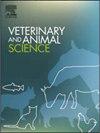德国绵羊生产系统的特性和各自育种性状经济价值的推导
IF 1.9
Q2 AGRICULTURE, DAIRY & ANIMAL SCIENCE
引用次数: 0
摘要
本研究的目的是推导出特定群集类型的绵羊育种目标性状的经济权重。群体聚类方法考虑了25个德国绵羊群体,包括与区域因素、管理因素、群体信息和社会经济特征相关的描述符。评价标准建议采用聚类分层聚类,将25头牛分别分配到3个不同的聚类中。这些集群主要在畜群规模、生产重点以及有机管理与传统管理实践方面存在差异。正在进行的基于支付意愿(WTP)的条件评估方法计算了12个育种目标性状的聚类特定经济权重,考虑了25个德国羊农,每1个遗传SD改进一个性状的假设预算为1000欧元,以及线性混合模型应用。WTP (P <;0.01)仅在性状饲料利用率方面被确定为第2类(最小二乘平均值= 101.65欧元)和第3类(最小二乘平均值= 9.46欧元)。将单个育种目标性状的最小二乘均值归纳为四类总体育种目标。“功能性”性状的重要性最高,但在聚类间存在差异。所有集群对包括尾巴长度在内的“健康和福利”特征类别的评价非常相似(范围从24%到29%),在集群1和集群3中,更强调“健康和福利”而不是“绩效”。因此,我们建议通过考虑生产系统的特殊性,调整绵羊育种目标,从生产转向健康、福利和功能。本文章由计算机程序翻译,如有差异,请以英文原文为准。
Characterization of German sheep production systems and derivation of respective economic values for breeding traits
The aim of this study was to derive economic weights for sheep breeding goal traits for specific cluster types. The herd clustering approach considered 25 German sheep herds including descriptors related to area-based factors, management factors, herd information and socio-economic characteristics. The evaluation criterion suggested the application of agglomerative hierarchical clustering with the respective allocation of 25 herds to 3 different clusters. The clusters mainly differed with regard to herd size, production focus, and organic versus conventional management practices. The ongoing contingent valuation approach to derive cluster specific economic weights for 12 breeding goal traits based on the willingness to pay (WTP) considering 25 German sheep farmers, a hypothetical budget of 1000 € for the improvement of a trait per 1 genetic SD, and linear mixed model applications. Significant cluster differences for the WTP (P < 0.01) were only identified for the trait feed utilisation with regard to clusters 2 (least-squares mean = 101.65 €) and 3 (least-squares mean = 9.46 €). Least-squares means for individual breeding goal traits were summed up into four overall breeding goal categories. The highest trait importance was expressed for “functional”, but displaying a variation among cluster. All clusters rated the trait category “health and welfare” including tail length very similar (range from 24 % to 29 %), with even stronger emphasize on “health and welfare” over “performance” in clusters 1 and 3. In consequence, we suggest to modify sheep breeding goals with a shift from production towards health, welfare and functionality, by consideration of production system particularities.
求助全文
通过发布文献求助,成功后即可免费获取论文全文。
去求助
来源期刊

Veterinary and Animal Science
Veterinary-Veterinary (all)
CiteScore
3.50
自引率
0.00%
发文量
43
审稿时长
47 days
 求助内容:
求助内容: 应助结果提醒方式:
应助结果提醒方式:


